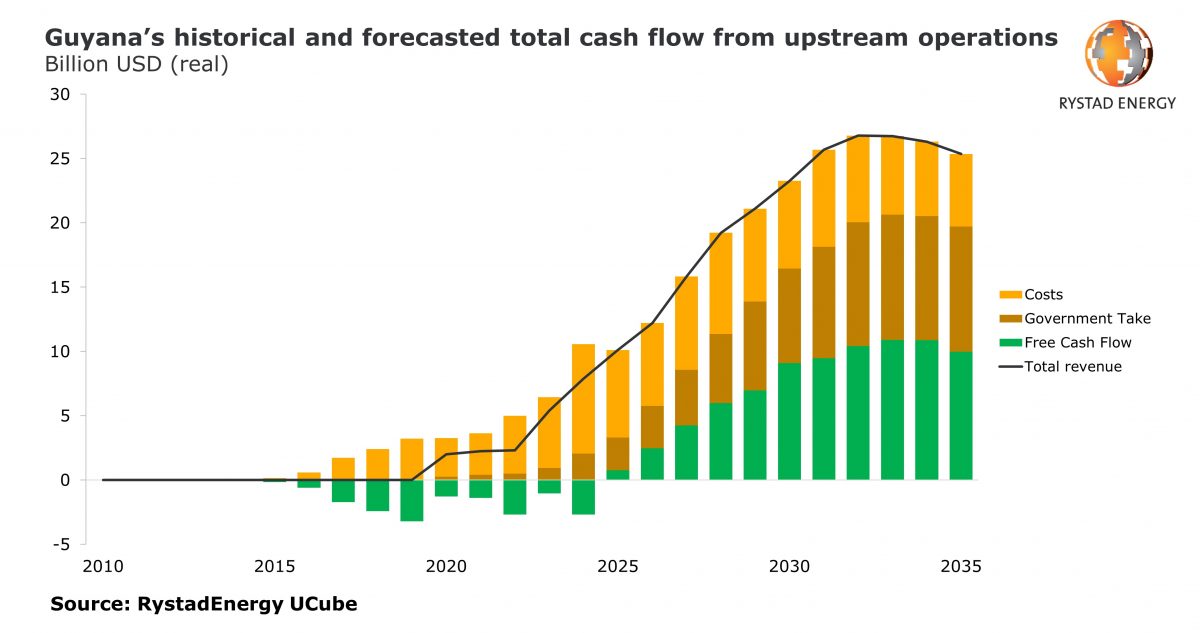Research company, Rystad Energy said today that Guyana’s oil production is projected to be 1.2 million barrels per day by 2030 and that total annual oil revenues could approach US$30 billion within 10 years.
This it said in a press release was according to fresh research it had done and comes in the wake of ExxonMobil announcing projected barrels of oil equivalent (BOE) at nearly eight billion in the Stabroek Block.
Today’s new research findings by the Norway-based Rystad also said that the current fiscal regime here is in line with other emerging oil and has countries.
Rystad, noting that Guyana’s fiscal take has been “heavily discussed over time” said today: “For Guyana, the average government take is 60%, which in our benchmarking overview places the country right between major producer Brazil at 63% and fledgling producers Mozambique and Mauritania, at 57%.
“We find the current fiscal regime in Guyana to be in line with other emerging oil and gas countries. As Guyana firms up its credentials as an attractive upstream destination, we expect that new awards of production sharing agreements will likely stipulate revised fiscal parameters, with the higher government take”.
The Rystad assertion comes just a day after anti-corruption watchdog Global Witness declared that Guyana stood to lose as much as US$55b from the poor negotiation of the 2016 Production Sharing Agreement for the Stabroek Block.
Noting that oil production started six weeks ago, Rystad said in the release that the fortunes of Guyana are poised for a “major transformation”.
It said that offshore oil production is expected to grow rapidly in the years to come and will yield “unprecedented revenues” for the Guyanese government.
“Since the initial discovery in 2015 of the giant Liza oil field in the prolific Stabroek block, Guyana has discovered more than eight billion barrels of oil resources,” noted Sonya Boodoo, Vice President of Upstream Research at Rystad Energy.
She cautioned that in order for Guyana to realize the full potential of these resources, a “stable regulatory and fiscal environment will be a key factor.”
Rystad said it forecasts that Guyana’s oil production could reach 1.2 million barrels per day by the end of the decade, lifting total annual oil revenues to about US$28 billion, assuming an oil price of about $65 per barrel.
“Government income in the country – projected to be a modest US$270 million or so in 2020 – is forecast to grow rapidly and could reach nearly US$10 billion annually within a decade. Putting that figure into context, Guyana’s gross domestic product currently stands at about US$3.7 billion”, Rystad said.
Between 2015 and 2019, it said that oil and gas companies invested around US$8.1 billion in exploration and development activities in Guyana’s offshore sector.
Rystad said that under the country’s fiscal regime, these companies assume all risks during the exploration phase, which explains the negative free cash flow seen thus far. It added that these costs – including both investments and operational expenses – will grow as new development projects are approved and new fields are brought on stream. At the peak, the annual costs are expected to reach around US$8 billion.
Rystad noted that Guyana’s fiscal regime and overall take has been heavily discussed over time and adverted to a 2018 International Monetary Fund paper advising Guyana’s government to increase government take for new licenses in order to reflect the impressive run of exploration successes in the Stabroek Block.
“The current fiscal regime for Stabroek involves a transparent profit-sharing contract with three main components: a 2% royalty, a profit oil level of 50%, and a cost recovery ceiling of 75%. The contract is reflective of the situation at the time of signing back in 1999, when multiple companies had encountered several dry exploration wells. At the time, E&P (exploration and production) companies were seen to be taking a considerable risk by conducting deepwater exploration in the region. To make such frontier drilling attractive, Guyana offered competitive fiscal terms,” Boodoo stated.
The release said that Rystad Energy has benchmarked the Stabroek fiscal regime against the fiscal regimes of other “frontier” and upcoming oil and gas producing countries, such as Brazil, the United States (deepwater Gulf of Mexico), Mozambique, Israel, Tanzania, Mauritania, Suriname, and the Falkland Islands.
To measure the impact of the fiscal regimes in these countries, the release said that Rystad Energy has run its economic model analysis on the Liza Phase 1 project and compared the results against the fiscal regimes for the peer group countries. From there it said that it derived the estimated government take under each country’s fiscal regime, calculating the split of profits between the exploration and production companies and the government. Rystad noted that government take is defined as the present value of the government take divided by the present value of the profit, where profit is revenue minus investments and operational costs.
Rystad describes itself as an independent energy research and business intelligence company providing data, tools, analytics and consultancy services to clients exposed to the energy industry across the globe.









